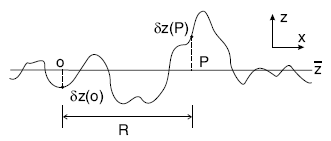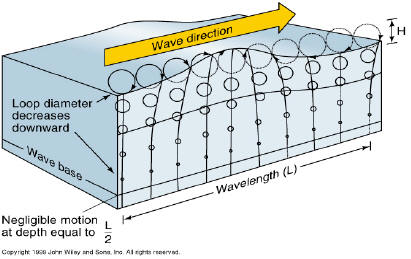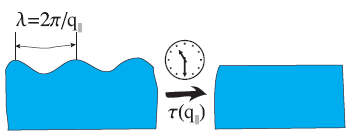|
|
 |
 |
|
Scattering from Liquid Surfaces |
|
|
Liquid surfaces have been of great interest to both the
theoretical and experimental communities since the pioneering
work of van der Waals [The
thermodynamic theory of capillarity under the hypothesis of a
continuous variation of density, J. D. van
der Waals, Verhandel. Konink. Akad. Weten. Amsterdam 1, 1
(1893)] more than a century ago. In his simple version of the
density functional theory, a liquid-vapor interface is viewed as
a finite region where the density smoothly changes from that of
the liquid to that of the vapor, and the equilibrium state
of this non-uniform system is obtained by minimizing the free
energy, which depends on both the local density and its spatial
derivatives. |
|
|
|
An alternative approach for describing a liquid
surface was proposed by Buff, Lovett, and Stillinger [Interfacial
density profile for liquids in the critical region,
F. P. Buff, R. A. Lovett, and F. H. Stillinger, Phys. Rev. Lett.
15, 621 (1965). DOI: 10.1103/PhysRevLett.15.621 ] , who
treated the surface as a sharp step-like profile decorated with
height variations attributed to the thermal excitations of
capillary waves. The emergence of high-brilliance
third-generation synchrotron radiation sources in recent years
enables a direct investigation of the liquid surface properties.
It turns out that the capillary wave model gives a very accurate
description of the in-plane structures and also predicts the
interfacial roughness much better than van der Waals's theory. |
|
To top |
|
| Description of liquid
surfaces - capillary wave theory |
|
|

FIG:
A typical surface profile |
|
|
|
In the real world,
there never exist absolutely smoother surfaces, and the surface
height always fluctuates in space for solids and in time, as
well, for liquids. Therefore, any given surface may be described
by a height contour function

However,
except for some strictly periodic surfaces, the knowledge of
exact surface profile is nearly impossible. If the local surface
structure is not of interest, a statistical treatment with only
a few parameters may apply to describe the surface morphology
sufficiently. For a homogenous, isotropic, and ergodic surface,
which is usually the case for liquid surfaces, we may introduce
the height-height correlation function

|
|
|
|
Wave excitations are always present on liquid surfaces. If the
effect of gravity is much smaller than that of the surface
tension, these waves are called capillary waves, which is
very important for most soft condensed matter surfaces. A
characteristic feature of capillary waves is that their
amplitude is much smaller than their wavelength. The movement of
molecules engaged in the formation of capillary waves is
schematically shown in the following figure. |
|

FIG:
Sketch of the particle motion in free capillary waves. The
circular orbits are shown. The amplitude of the orbits decreases
exponentially with increasing depth. In the case of a thin film
the motion is squeezed vertically, leading to ellipsoidal
orbits. This simple picture is valid in the absence of
viscosity. |
|
To top |
|
|
|
|
|
Scattering from liquid surfaces |
|
|
|
We are interested in the elastic scattering regime, so that the
incident and exit waves vectors have the same amplitude. A
typical scattering geometry is displayed below. |
|

FIG:
Sketch of the surface (xy plane) scattering geometry. |
|
|
|
In
the case of small qz values, the surface
scattering structure factor is simply the Fourier transform of
the height-height correlation function C(R), i.e.,
 . .
Therefore a measurement of the structure factor can reveal both
the static and dynamic properties of the liquid surface.
Hydrodynamic theory (Navier-Stokes equation) is successfully
employed to calculated the damping rate and propagating
frequency of the capillary waves. For highly viscous
polymer melt, capillary waves are over-damped, which means the
propagating modes are suppressed by the high viscosity. This
over-damping behavior is characterized by an in-plane wave
vector (i.e., the capillary wave length) dependent relaxation
time t(q||),
which can be measured by surface sensitive
XPCS
experiments. |
|

FIG:
Physical meaning of the over-damped relaxation time constant. |
|
To top |
|
|
|
|
|
More on x-ray scattering from matters |
-
X-ray scattering from soft-matter
thin films, by Metin. Tolan, Springer-Verlag
1999.
- X-ray surface scattering studies of liquid crystals, by
Sunil K. Sinha, Chapter 9 in
Liquid Crystals: Experimental Study
of Physical Properties and Phase Transitions,
edited by Satyendra Kuma, Cambridge University Press
2001.
- Ordering and growth of Langmuir-Blodgett films: X-ray
scattering studies, by J. K. Basu and M. K. Sanyal,
Phys. Rev. 363, 1 (2002).
DOI: 10.1016/S0370-1573(01)00083-7.
-
X-ray intensity correlation
spectroscopy from fluid surfaces, Ph.D. thesis
by Tuana Ghaderi, University of Dortmund and University of
California at San Diego, 2006.
|
|
To top |
|
|
 |
|
|
|
|
|
|
|
 |
|
